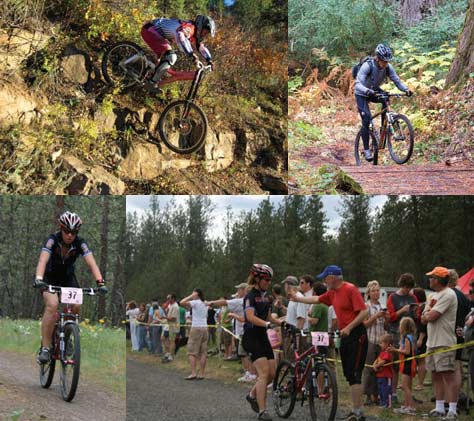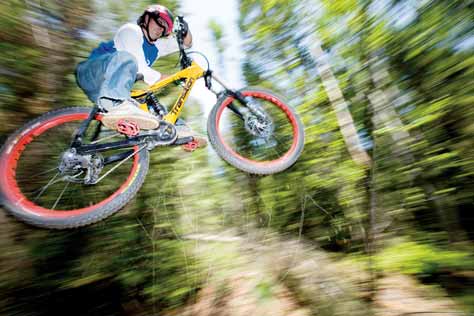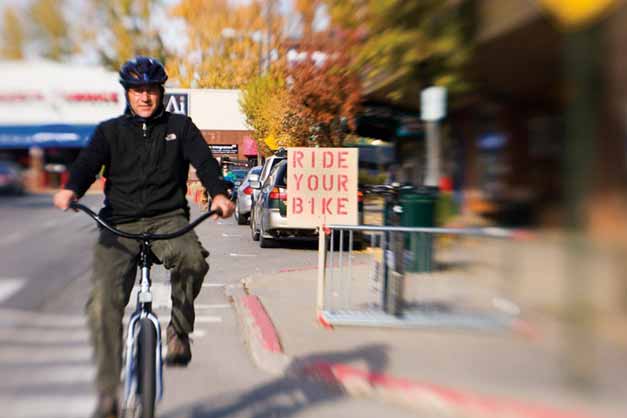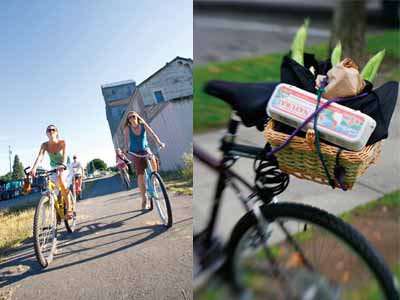Drops, descents and downright nuttiness
Hordes of outdoor enthusiasts prefer fat tires
By Cate Huisman
From the moment in the 1970s that some long-haired Californian first added fat tires to an old cruiser and careened down the hills of Marin County, divergent paths have led to extremes of mountain biking. On the adrenaline-inducing end, body-armor-wearing downhillers ride monstrously heavy bikes over drops like Schweitzer's Altar Boy that make their mothers wish they had insisted their kids play golf instead. At another extreme, cross-country racers with quads of steel relish trips with lung-challenging, 2,000-foot climbs and elbow-challenging, rock-infested descents, and a particular sort likes to see how far they can go in a 24-hour period without sleeping. In their midst are the hordes of outdoor enthusiasts who find they just enjoy riding ever lighter, ever more high-tech, fully suspended bicycles.
"Suspension" to a mountain biker means that the bike absorbs some of the shocks of travel, just as the suspension on a car makes the ride smoother for its occupants. But mountain bikers aren't necessarily looking for a smoother ride - although some of the more mature ones may be said to appreciate it. They like the suspension because it enables them to take on rockier, rootier, droppier climbs. Such bikes have front forks that travel (or telescope) to absorb shock anywhere from 2 or 3 inches (for the simpler trail bicycles) to 8 inches or more (for the gnarliest of downhill junkies). "Full suspension" bikes also have a shock absorber in the back, under or behind the seat.
At the heart-stopping, drop end of the rider spectrum is Sandpoint native daughter Emma Millar, age 20, who rides a custom-made pink Ellsworth bike with a front fork that absorbs a lot. Although she also competes in cross-country mountain bike events and road races, Millar was sidelined by a knee injury last year and so focused on downhill events last fall, when she took the Collegiate Downhill National Championship.
|
 Clockwise from bottom right, Emma Millar picks up her bike from mechanic Larry Baggett at the grand prix start of the 2008 24-hour race in Spokane, powers on the third lap of the same race (Cate Huisman photos), and trains for more desperate downhill competition. Charles Mortensen trains on his bike. (Doug Marshall photo) Clockwise from bottom right, Emma Millar picks up her bike from mechanic Larry Baggett at the grand prix start of the 2008 24-hour race in Spokane, powers on the third lap of the same race (Cate Huisman photos), and trains for more desperate downhill competition. Charles Mortensen trains on his bike. (Doug Marshall photo)

Jeff Schissler defies gravity on the Horse Barn Trail. (Photo by Chris Guibert)
|
Equally gnarly is local Charles Mortensen, age 48, who particularly excels at 24-hour races. Mortensen completed 13 laps of the 24-hour Round the Clock mountain bike race in Spokane last year – that's 195 miles in 24 hours – and he did it on a single-speed bike. If your only experience of biking is the three-speed you rode to school when you were a kid, it's hard to appreciate the magnitude of this accomplishment. It's useful to know that most mountain bikes have 15 to 24 speeds (kind of like a log truck), and the low gears make it much easier to go up hills. Mortensen likes the single-speed "mostly because of the simplicity. It's a different challenge. You don't have any gears to worry about; it's tougher on the climbs, but you get to rest a bit on the descent."
He rode a geared bike in last summer's 24 Hours for Hank road event, in which he did 15 laps of the 19-mile route, or 285 miles. And he started on a geared bike in the 24-hour world championships in Canada last year, "but I had to shift to single-speed because there was so much mud – it was just pouring rain the whole time – that my gears quit working."
Mortensen admits that the 24-hour endeavors "are a little bit nutty." Most people, in fact, compete on teams in 24-hour races; they ride every third or fourth or fifth lap, sleeping while their teammates do the laps in between. Millar is the other notable exception; she wowed the local cycling world by riding 13 laps solo in the Round the Clock race when she was just 18.
For the rest of us who aren't remotely like Millar or Mortensen but who like to ride a pretty good mountain bike on moderately challenging singletrack, options for trips abound in and around Sandpoint. (To a mountain biker, "singletrack" means what most of us think of as "trail," that is, a 1- to 3-foot-wide dirt path, as opposed to an old dirt road, however overgrown, that is wider and therefore easier to ride.)
The closest opportunity is right at the western edge of town, where the Pend Oreille Pedalers bicycle club continues to build and maintain trails and to conserve access to once-wild land that has been rapidly filling with oversize homes. Thanks in large part to their members' efforts, this network of trails on Syringa Heights provides numerous after-work ride options.
Just northwest of town, Schweitzer Mountain Resort has built a new trail for mountain bikers that descends 2,000 vertical feet over 7 miles from the top of the Great Escape quad chairlift. Designed by mountain bike trail specialists Nat and Rachael Lopes, Beargrass Cruiser (as the new trail was named via a contest among Schweitzer's winter staff) includes several practice areas where cyclists can work on skills at varying levels of difficulty. For the price of a summer lift ticket, riders can descend this track several times in a day and work on harder challenges and obstacles with each descent.
From there, downhillers can graduate to the steeper drops that were used when Schweitzer hosted the National Off-Road Bicycling Association (NORBA) nationals a few years ago, including the infamous Altar Boy drop that your mom doesn't want to know about. Cross-country cyclists can move on to the cross-country ski trails, which provide a variety of levels of difficulty depending in part on what rocks and roots have eroded out from under the melting snows.
Almost as close but much easier to ride are the routes circumnavigating Round Lake and Gamlin Lake (each a short drive or longer road ride away) and the system of trails at Dover Bay, a resort community where paths wind through the open spaces and public waterfront. More difficult close-by favorites include the cluster of routes on Gold Hill across the Long Bridge; the objective with Trail No. 3 is to get around all 20-plus switchbacks without letting a foot leave a pedal.
If you're willing to drive a little and you're not afraid to get mildly lost, Farragut State Park, 25 miles to the south, has miles of singletrack meandering through the abandoned remains of a World War II naval base. Farragut is more fun if you don't try to follow a preplanned route too carefully; the tangled network of trails has led to the center part of the park being called "the vortex." If you just keep pedaling, you'll get back to your car eventually.
A bit longer drive will take you to another set of trails at Priest Lake. The lake's location offers some opportunities for significant climbs for those who are up for it, although there are also more level routes following the lakeshore. Favorite trips run north to and around Upper Priest Lake, where no motorized travel is allowed on land or water, making for a particularly peaceful pedaling experience.
The only problem with mountain biking in a town like Sandpoint is that winter comes, and it can stay late in the mountains. Biking over the sharp crystals of sloppy, melting snow tends to make for bloody crashes, and riding trails too early in muddy meltwater leads to erosion and destruction of the tread.
Better to do a few more spinning workouts at the gym while mumbling words like those of Emma Millar. Verging on impatience with detailed questions from a reporter about her favorite events, she responded simply, "I just want to ride my bike."
May it be that way with you.
|
-Rides for beginner to hard-core-
|
|

Bike mechanic Steve York pedals on First Avenue past Outdoor Experience's sign that promotes riding.
(Photo by Marsha Lutz)
Life on two wheels
By Cate Huisman
Sandpoint bicycle mechanic extraordinaire Larry Baggett arrives at his shop on a snowy February morning on a bike that's set up for snow, with full fenders and bumpier-than-average tires, which a close inspection reveals are actually studded. And he's not alone. A few blocks away, Waldorf School teacher Thomas Jenkins is wheeling his way to work from his home on First Avenue, and special education teacher Ben Wimmer is heading in on the Dover bike path to his job at Farmin Stidwell School. Wimmer has studded tires too, but Jenkins eschews them for his short commute, instead opting for a single, annual fall to help him remember how to ride on snow: "It's my November-December ritual; I have to go around a slippery corner once and fall down as a reminder."
Although biking might not be the year-round, all-around way to get around for the rest of us that it is for these die-hards, we do find Sandpoint an easy place to get around on two wheels. In fact, Sandpoint's Bicycle Committee is in the process of applying to join Coeur d'Alene and the Wood River Valley (home of the Sun Valley ski resort) as one of three areas in Idaho named Bicycle Friendly Communities by the League of American Bicyclists.
Geographically, the town is a natural for the designation: It's flat, so commuters and students and errand runners needn't haul heavy loads uphill or arrive at an appointment soaked with sweat, and recreational cyclists can take advantage of relaxing, waterfront rides free of hills. For those seeking more of a workout on wheels, there are many paved roads with little traffic for long road rides, and mountain trails of varying difficulty are available for mountain bikers right at the edge of town.
The paved path Wimmer traverses, as well as the enormously popular path across the Long Bridge and south to Sagle, are the result of years of work by North Idaho Bikeways, one of the first groups in town to address the needs of cyclists and pedestrians in an area with ever-growing auto traffic. These paths enable cyclists of all abilities to get into town from the south and west along major highways unencumbered by the presence of motorized traffic.
Going north and east is a bit harder, but determined cyclists can follow a paved path along Boyer Avenue as far north as the University of Idaho Extension Station, where they must drop down to Sand Creek, cross the oddly named Popsicle Bridge, and head up to U.S. Highway 95. Here a certain amount of mojo and motivation are necessary to get across the traffic to the commercial delights of Ponderay.
This is the route that another perennial commuter, Sandpoint High School science teacher Woody Aunan, pedals 15 miles round-trip daily from his home in the Selle Valley. "I loathe being hermetically sealed in an auto," says Aunan, who has cycled regularly since high school. Aunan dealt with winter snows by riding a homemade tricycle for a while, but found its weight and resistance overwhelming. So he switched to a bulldog of a bike aptly called a Surly Pugsly; it has wide, soft tires that absorb the slings and arrows of winter commuting.
|

With bike paths through and around town, Sandpoint lends itself to a biking lifestyle. (Photos by Woods Wheatcroft and Marsha Lutz)
|
Winter or summer, habitual riders have varying reasons for using two wheels instead of four. Some are introspective: Aunan mentions that his route provides "ample time to reflect," and Wimmer talks about "getting the cobwebs out" before work each day. Others are ideological: Aunan abhors "using fossil fuels without good reason," and Jenkins says simply that he uses a bike "to save the earth."
Fitness is a big one too: Wimmer made the commitment to year-round pedaling after his sons were born. "With young kids, it's harder to get exercise," he says. "So I decided I'm going to build in some exercise, save myself some money and relax a little on the way home." Relaxing, for Wimmer, means having fun on the climbs and drops of the mountain bike trails above the Dover path as he returns from work.
For others out for a workout instead of a commute, the Pend Oreille Pedalers bicycle club holds rides every Monday evening in summer, usually traversing 20 to 30 miles and lasting an hour to an hour and a half. Posts on their Web site provide updates on local road conditions, and ride coordinator Jim Doudna suggests that road riding is becoming more popular each summer.
Whether you're riding to get a workout or to get around, the bottom line is this: Biking is just plain fun. It's fine that it lessens pollution, saves money, helps you stay healthy, reduces traffic congestion, and spares you the necessity of finding a place to park. But the wind in your face, the freedom to duck down an alley or bike path, and for some, the opportunity to fly off a drop or jump a rock, are way more fun than a machine-induced workout in a gym or that hermetically sealed travel experience Aunan describes.
Biking can also be way more comfortable than many may remember it. While draping yourself over dropped handlebars is still an option for those who want to train hard and ride fast, many are instead sitting happily erect on "comfort bikes." Brian Anderson of Sandpoint Sports says, "Last summer our top selling bike was a comfort hybrid bike; it's a bike that's built around just being comfortable & it's easier on the back, neck and wrists." Bikes like this tend to congregate at the Sandpoint Farmers Market at Farmin Park on weekends, and they're seen departing with carrots and bread and flowers sticking out of traditional wicker baskets hanging off the front handlebars (or less aesthetically pleasing but equally functional milk crates attached to rear racks with bungee cords).
Cycling in town, however, is not for the timid. Riders must share the street with cars, which can be intimidating, and though riding the alleys is a reasonable alternative much of the time, some riding in the street is usually necessary. Fortunately, the Sandpoint Bicycle Committee is at work on this too, trying to find ways to make getting around town safer and easier for cyclists. Striping to indicate bicycle routes will be painted along the entire lengths of Boyer and Division avenues this summer, and the committee is also working with the municipalities of Kootenai and Ponderay to connect to them with safe bicycle routes.
If you're recreating instead of commuting, there are several pleasant rides along the lakeshore and river (see story, page 55). Doudna also recommends the roads of the Selle Valley north of town as having light traffic and minimal bumps that make for good road riding. And when those kinds of rides begin to sound too flat and easy, you'll want to relax the way Woody Aunan does. During the school year he limits his biking to his commute, but "in the summer I like to ride up Schweitzer to keep fit."
Three road rides to get your legs pumping
With the kids: If you're new in town, get the family enthusiastic about cycling by taking the easy, traffic-free bike path out to Dover Bay. Pedal for three, wide, flat miles alongside U.S. Highway 2, continuing straight past a park bench and under the bridge where the road crosses over the railroad tracks. Where the path curves left, cross Railroad Avenue and find it again on the other side, paralleling Mill Street to the river through Dover Bay waterfront community. The Dover Bay Café is a great place for a sandwich or salad on the deck overlooking the river before you pedal home.
More of a workout: Ride south across the Pedestrian Long Bridge and turn left on Bottle Bay Road, about a half mile after you leave the bridge. Follow this road around Contest Point and to the head of Bottle Bay; then continue for another mile or more to Sagle Road. Here you turn right to come back to U.S. Highway 95 through a small pass between Gold Hill and Grouse Mountain (700-foot climb). Total distance for the loop is about 25 miles, and you'll have close-up views of the lake followed by a pastoral pedal through farmland back to the highway.
Longer and scenic: At the south end of the Long Bridge, take a right on Lakeshore Drive and ride about 8 miles to where the pavement ends. Continue off the pavement – on a good, hard-packed sealed dirt road – for a couple of miles to a junction with Dufort Road. Turn right here for a scenic ride along the south shore of the Pend Oreille River; then cross back to the north shore on the bridge at the small, historic town of Priest River. From here you can ride back into town along the wide shoulder of U.S. Highway 2. Total distance is about 50 miles.
– Cate Huisman
|
-What to do on two wheels-
Biking events, group activities fill the summer
|
|
|